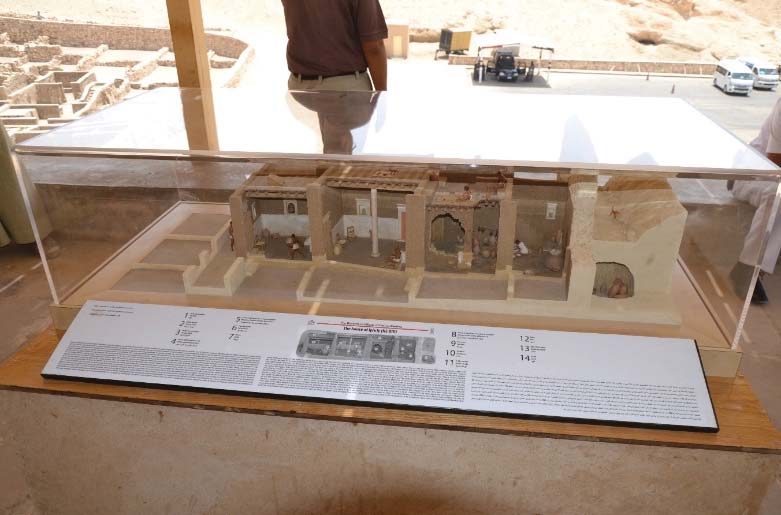ИНТЕРПРЕТАЦИЯ И КУЛЬТУРНОЕ НАСЛЕДИЕ: АНАЛИЗ СИСТЕМЫ УКАЗАТЕЛЕЙ В ДЕЙР ЭЛЬ-МЕДИНЕ.АРХЕОЛОГИЧЕСКИЙ ПАМЯТНИК В ЛУКСОРЕ, ЕГИПЕТ
Keywords:
интерпретация, указатели, дизайн, Дейр эль-Медина, опыт посетителей, контрольAbstract
Археологические памятники требуют выполнения активного контроля и проведения исследований, так как в противном случае вопросы по их изучению полностью возлагаются на посетителей. Указатели и вывески делают экскурсии более комфортными и полезными для туристов, а также позволяют направлять посетителей по организованным маршрутам для сведения к минимуму загруженности и негативного воздействия на памятники. Успешное применение указателей не только позволяет сообщать посетителям информацию о направлении и прочие сведения, но также играет ключевую роль в получаемом ими опыте и впечатлениях от посещаемого объекта (Фальк и Диркинг, 1992). В Дейр эль-Медине имеется целый ряд проблем, связанных с контролем объекта культурного наследия, многие из которых обусловлены практикой интерпретации, и наиболее значимой из них является неполная и несогласованная интерпретация информации на археологическом объекте. Проблема усугубляется вследствие неиспользования руководством объекта и их партнерами надлежащих практик интерпретации и нехватки обученных специалистов, выполняющих полевые исследования. В работе представлено описательное аналитическое исследование связанных с интерпретацией носителей информации, т.е. указателей, как правило используемых на объектах культурного наследия. Целью исследования является определение схемы распределения указателей на территории археологического объекта Дейр эль-Медина, анализ внешнего вида (дизайна) указателей, а также подбор указателей определенного типа в зависимости от содержания и выполняемых функций с точки зрения получения посетителями объекта максимально полезного опыта.
References
Aplin, G. 2002. Heritage identifi cation, conservation and management. South Melbourne: Oxford University Press.
Beck, L., & Cable, T. T. 1998. Interpretation for the 21st century: Fifteen guiding principles for interpreting nature and culture. Urbana.
Benedict G. Davies, 1999. "Who’s Who at Deir el-Medina", A Prosopographic Study of the Royal Workmen’s Community Nederland's Institute.
Brochu, L. 2003. Interpretive planning: The 5-M model for successful planning projects. Fort Collins, CO: Inters perses.
Bruyère, Bernard, 1929 "Rapport sur les Fouilles de Deir el Medineh (1928) Le Caire, Imprimerie de l'Institut Francais d'Archeologie Orientale.
Cleere, Henry, 2010. Management Plans for Archaeological Sites: A World Heritage Template”, Conservation and Management of Archaeological Sites 12.1, 4–12.
Cole, D. N., Hammond, T. P., & McCool, S. F. 1997. Information quantity and communication eff ectiveness: Low – impact messages on wilderness trailside bulletin boards. Leisure Sciences, 19(1), 59–72.
Creswell, J. W. 2009. " Research design: Qualitative, quantitative, and mixed methods approach (3rd Ed.). Los Angles: Sage. Ernest, P. (1998).
Drew, G., Grocke, C., & Cahalan, P. 2002. Guidelines for producing trail signage: Direction, interpretation and management. SA Tourism Commission and Recreation Trails Signage and Interpretation Working Group, 3, 1–43.
Edwards, C. 1994. Interpretive project guide book. Portland, OR: U.S.D.A Forest Service, Pacifi c Northwest Region.
Falk, J. H., & Dierking, L. 1992. The museum experience. Washington, DC: Whales back Books.
Graham, B. 2000. The past in place: Historical geographies of identity. In B. Graham & C. Nash (Eds.), Modern historical geographies (pp. 70–99). Harlow: Pearson Education.
Gross, M., Zimmerman, R., & Buchholz, J. 2006. Signs, trails, and wayside exhibitions: connecting people and places (3rd ed.). Steven Point, WI: UW-SP Foundation Press.
Ham, S. H. 1992. Environmental interpretation: A practical guide for people with big ideas and small budgets. Idaho: North American Press.
Hassan, Fekri, 2001. Strategic Approach to Egypt's cultural Heritage. Cairo: CULTNAT, Egypt, Final Report, (Cult Nat), Cairo p.1-66-79.
Hughes, M., & Morrison-Saunders, A. 2002a. Impact of trail-side interpretive signs on visitor knowledge. Journal of Ecotourism, 1(2–3), 122–132.
Jamieson, W., & Noble, A. 2000. A manual for interpreting community heritage for tourism. Training and Technology Transfer Program, Canadian Universities Consortium Urban Environmental Management Project at AIT.
Jensen, K. A. 2006. Eff ects of the artistic design of interpretive signage on attracting power, holding time and memory recall. PhD Diss. Humboldt State University.
Lewis, William 1980. Interpreting For Park Visitors. Eastern Acorn Press.
McDowell, A.G. 1999. "Village life in ancient Egypt". Laundry lists and love songs Oxford: Oxford University Press.
Mollerup, P. 2005. Way showing: A guide to environmental signage principles & practices. Baden: Lars Müller.
Moscardo, G., Ballantyne, R., and Hughes, K. 2003. Interpretive signs-talking to visitors through text. In
Moscardo, G., Woods, B., & Saltzer, B. (2004). The role of interpretation in wildlife tourism. In K.NSW Heritage Offi ce. 2005. Interpreting Heritage Places and Items Guidelines
Screven, C. 1995. Visitor-based exhibit planning: A question of survival. In C. Scott (Ed.). Evaluation and visitor research in museums: Towards 2000, Sydney: Powerhouse, 81–82.
Shaikhon, Ahmed. 2015. Lack of Adequate Management Plan in Deir El Medina the Craftsmen and Artists Village in Luxor, Universite’ Paris 1 Panthe’on-Sorbonne.
Tilden, Freeman. 1957. Interpreting Our Heritage, the University of North Carolina Press, Chapel Hill.
Timothy, D. J., & Boyd, S. W. 2003. Heritage tourism. Prentice Hall: Pearson Education.
Timothy, Dallen J. 2011. Cultural Heritage and Tourism. Bristol: Channel View Publications.
Trapp, S., Gross, M., & Zimmerman, R. 1994. Sign, trails, and wayside exhibits: Connecting people and places. Stevens Point, WI: UW-SP Foundation Press. U.S. Forest Service. (2009). Interpretive signs, chapter 9.
Uzzell, D., & Ballantyne, R. 1998. Contemporary issues in heritage and environmental interpretation: Problems and prospects. London: The Stationary Office.
Veverka, J. A. 2011. Interpretive master planning: Volume one: Strategies for the new millennium. Cambridge, MA: Museums.
Weeks, K. 2010 "managing the west bank, Cairo, The American University in Cairo Press.

Downloads
Published
How to Cite
Issue
Section
License
Copyright (c) 2019 Ahmed Motawea Hussein Shaikhon

This work is licensed under a Creative Commons Attribution-NonCommercial 4.0 International License.







